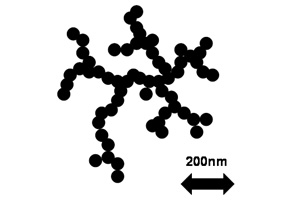Atmospheric Soot Particles
Background
Soot particles are important in the atmosphere because they are strongly absorbing of both solar and terrestrial radiation. While soot particles are thought to be responsible for a relatively small percentage total aerosol mass, their effect on total column aerosol optical depth is much more significant. As efficient absorbing particles they have the potential to change the temperature profile in the atmosphere and the radiative balance of the earth/atmosphere system. If present in cloud particles they will also affect quantities of energy absorbed by the cloud, so influencing temperature and cloud lifetime. Further if soot particles are deposited to ice surfaces – glaciers or polar ice sheets – this will affect quantities of energy absorbed by these surfaces, and hence melting rates. It is also thought that soot particles may act as ice nuclei in clouds.
Soot is emitted into the atmosphere from combustion sources such as biomass burning, industrial and vehicle emissions. It is estimated that 8Tg/year of soot is emitted globally, accounting for about 5% of the total mass of anthropogenically produced aerosol. Studies using electron microscopy have shown that soot from combustion sources is often fractal in nature, consisting of many tiny particles loosely bound together.

Diagram of a fractal soot particle. Freshly emitted soot particles have been observed to consist of many tiny near spherical particles loosely bound together, the resulting particle having a relatively low fractal dimension. These tiny particles are typically 30-40nm in diameter, the particle in this diagram is composed of 61 such particles and has an overall diameter of approx 600nm. The actual mass of this particle would be 2.8fg, compared to 159fg if it were a solid particle of the same overall diameter. This fractal structure is expected to collapse as these particles are processed in the atmosphere, significantly changing the optical properties of the particle.
This fractal nature effects light scattering and aerodynamic properties of aerosol making accurate measurements with some types of instrumentation difficult, and complicating assessments of its radiative effects in the atmosphere. Lab experiments have also shown that the form of combustion generated soot is dependant on combustion conditions, and that soot may also be emitted with a variety of coatings made up of other materials, which may further alter its optical, aerodynamic and hygroscopic properties. Once in the atmosphere soot particles may be further processed through the addition of material in the form of a coating, or oxidation of existing coatings. While pure soot particles are hydrophobic, and are not considered to be cloud condensation nuclei under atmospheric conditions, once coated these particles are thought to be able to act as cloud condensation nuclei, hence soot may become incorporated into cloud droplets.
Measurements
Traditionally soot instruments have inferred soot content from measurements of light absorption, either by particles suspended in an airflow, or by particles which have been collected onto a filter. These instruments are not specific to soot (although soot is the major light absorbing component of atmospheric aerosol) and are also affected by refractive index and humidity issues. They are also not able to provide information on the mixing state of soot as single particles. The recently developed SP2 is highly specific to soot, and is able to provide the mass of soot present in each particle, regardless of mixing state or fractal dimension. This makes it a very valuable tool for the study of abundance, processing, mixing and transport of soot in the atmosphere. When combined with other measurements it is possible to gain further insights into the nature of the particles measured.